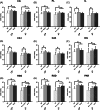Photobiomodulation increases brain metabolic activity through a combination of 810 and 660 wavelengths: a comparative study in male and female rats
- PMID: 38214813
- PMCID: PMC10786747
- DOI: 10.1007/s10103-023-03966-0
Photobiomodulation increases brain metabolic activity through a combination of 810 and 660 wavelengths: a comparative study in male and female rats
Abstract
Photobiomodulation (PBM), an emerging and non-invasive intervention, has been shown to benefit the nervous system by modifying the mitochondrial cytochrome c-oxidase (CCO) enzyme, which has red (620-680 nm) or infrared (760-825 nm) spectral absorption peaks. The effect of a single 810-nm wavelength with a combination of 810 nm and 660 nm lights in the brain metabolic activity of male and female rats was compared. PBM, with a wavelength of 810 nm and a combination of 810 nm and 660 nm, was applied for 5 days on the prefrontal cortex. Then, brain metabolic activity in the prefrontal area, hippocampus, retrosplenial, and parietal cortex was explored. Sex differences were found in cortical and subcortical regions, indicating higher male brain oxidative metabolism, regardless of treatment. CCO activity in the cingulate and prelimbic area, dentate gyrus, retrosplenial and parietal cortex was enhanced in both treatments (810 + 660 nm and 810 nm). Moreover, using the combination of waves, CCO increased in the infralimbic area, and in CA1 and CA3 of the hippocampus. Thus, employment of a single NIR treatment or a combination of red to NIR treatment led to slight differences in CCO activity across the limbic system, suggesting that a combination of lights of the spectrum may be relevant.
Keywords: Brain metabolism; Cytochrome c-oxidase; Photobiomodulation; Red light; infrared light; wavelength.
© 2024. The Author(s).
Conflict of interest statement
No.
Figures




Similar articles
-
Methylene blue and photobiomodulation recover cognitive impairment in hepatic encephalopathy through different effects on cytochrome c-oxidase.Behav Brain Res. 2021 Apr 9;403:113164. doi: 10.1016/j.bbr.2021.113164. Epub 2021 Feb 4. Behav Brain Res. 2021. PMID: 33549685
-
Photobiomodulation Response From 660 nm is Different and More Durable Than That From 980 nm.Lasers Surg Med. 2021 Nov;53(9):1279-1293. doi: 10.1002/lsm.23419. Epub 2021 May 16. Lasers Surg Med. 2021. PMID: 33998008
-
Histochemical mapping of the duration of action of photobiomodulation on cytochrome c oxidase in the rat brain.Front Neurosci. 2023 Aug 28;17:1243527. doi: 10.3389/fnins.2023.1243527. eCollection 2023. Front Neurosci. 2023. PMID: 37700747 Free PMC article.
-
Mechanisms and Mitochondrial Redox Signaling in Photobiomodulation.Photochem Photobiol. 2018 Mar;94(2):199-212. doi: 10.1111/php.12864. Epub 2018 Jan 19. Photochem Photobiol. 2018. PMID: 29164625 Free PMC article. Review.
-
Photobiomodulation CME part I: Overview and mechanism of action.J Am Acad Dermatol. 2024 Nov;91(5):793-802. doi: 10.1016/j.jaad.2023.10.073. Epub 2024 Feb 1. J Am Acad Dermatol. 2024. PMID: 38309304 Review.
Cited by
-
The Role of Photobiomodulation to Modulate Ion Channels in the Nervous System: A Systematic Review.Cell Mol Neurobiol. 2024 Nov 23;44(1):79. doi: 10.1007/s10571-024-01513-1. Cell Mol Neurobiol. 2024. PMID: 39579175 Free PMC article.
-
Effects of transcranial photobiomodulation in cerebral circulation and brain neural oscillations: a systematic review.Lasers Med Sci. 2025 Aug 22;40(1):341. doi: 10.1007/s10103-025-04601-w. Lasers Med Sci. 2025. PMID: 40844561 Review.
-
Photobiomodulation improves functional recovery after mild traumatic brain injury.Bioeng Transl Med. 2024 Oct 11;10(2):e10727. doi: 10.1002/btm2.10727. eCollection 2025 Mar. Bioeng Transl Med. 2024. PMID: 40060762 Free PMC article.
References
-
- Mester E, Ludány G, Selyei M, et al (1968) The stimulating effect of low power laser rays on biological systems. Laser Rev 1:3
-
- Mussttaf RA, Jenkins DFL, Jha AN (2019) Assessing the impact of low level laser therapy (LLLT) on biological systems: a review. Int J Radiat Biol 95:120–143. 10.1080/09553002.2019.1524944 - PubMed
MeSH terms
Substances
Grants and funding
LinkOut - more resources
Full Text Sources
Miscellaneous

